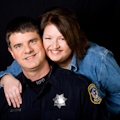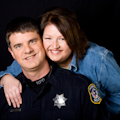Changing Times, Changing Gear, and How It Plays with the Public
I picked up a brand new exterior vest carrier last weekend, after long wanting a change in how I dressed and carried my gear, and couldn’t be happier. This isn’t my first outer carrier, having gone through two before and beaten them both into tattered submission, but it is the most advanced, comfortable, and utilitarian yet. Following the trend, my department had approved outer carriers equipped with molle gear and more and more of us have been making the switch to carrying most of what we used to keep around our waist to our vests.
After my last carrier had “given up the ghost” due to terminal Velcro failure and having sun-faded to a deep, rich (but definitely non-regulation) purple, I’d first gone back to a very traditional look: button down shirt, straight leg and sharply creased pants, boots, and leather gear all worn on a standard gun belt. A clean, classic look and one I like a lot. Eventually, I switched to BDU Cargo Style pants, not because I particularly like them but because I can pack a lot of stuff in the pockets and make my life easier. Everything else stayed the same, or would have...
If I had stayed the same, and had the department’s and society’s expectations of me stayed the same – the same age and no nagging little injuries here and there, more flexibility in what gear I would carry and how – I’d probably have stayed with that more classic look. But things do change and we have to adapt, so I did, and I’m very happy with what I’ve chosen.
The main reason I chose to go with the style and set-up of vest carrier I did was comfort. Simply put, as we get older things start to hurt. Accumulated injuries remind us of past fun and misadventures, and that “if you want to dance (or, say, play a lot of football), there’ll come a time you have to ‘pay the fiddler.’” Joints aren’t as flexible, muscles don’t warm up as fast, and sitting in a cramped squad atop a stiff, overloaded gun belt day in and day out is hell on the body. Moving the tools of the trade up and away from the hips gave near immediate relief! I like the look of it, too. It’s sharp looking and just makes sense from an ergonomic and utilization standpoint. But there is something else I’ve noticed about these vests, mine and others, which fits into recent public complaints about law enforcement: the charge that American law enforcement is becoming “militarized.”
Although still far from the full riot gear worn by some officers (and criticized by some of the public and media) serving during high profile protests, demonstrations, large-scale violence, and even in anticipation of merely possible incidents, these carriers are much more “weapon forward” than gun belts. The average citizen talking to an officer wearing a traditional uniform set-up is aware of at least the sidearm, and possibly other tools, but they are at the periphery being on the belt. Interactions are face-t-face, with eye movement to the chest, torso, and shoulders normal. Now, put ASP, extra magazines, pepper spray, Taser, flashlight, radio, possibly handcuffs and even a BUG right ON the torso of the officer to whom they are speaking and there will be an inevitable perceptual change. For a lot of citizens, this may be alarming or put up walls. We need to be cognizant of this.
Notice I am NOT criticizing the vest carriers themselves, or how they are set up, or the officers wearing them. I wear one and wouldn’t go back, it’s so awesome and comfortable. But I am also NOT criticizing the citizen who might be put off. They are not “snowflakes” or any other epithet some will throw their way; they are simply reacting and probably unconsciously. Respect it even if you don’t understand it.
The “tools of the trade” are changing. When I started nearly 21 years ago we were issued and expected to carry a pistol, ASP, pepper spray, a set of handcuffs, and radio. Back-up guns (BUGs) were optional, and most of us invested in at least one extra set of cuffs. Flashlights were large and stored in the car, to be grabbed as needed, but most of us purchased our own small but powerful lights to keep on us at all times. Now, we are all also required to carry a Taser, and by policy firearm, Taser, ASP, and pepper spray must ALL be on our person when working in a patrol function. I understand the reasoning behind this from an administrative CYA point-of-view, but no wonder it gets uncomfortable!
Be aware of perceptions! How we are perceived by the public we serve is critical to our success in serving them, and in gaining their cooperation and support. As long as most of the public perceives us as acting on their behalf, as their agents and in accordance with their wishes, the community will largely back our authority and its exercise. We also must never lose sight of how quickly perceptions change in response to our words and actions, or even appearance and demeanor. The changing demands of the job, and of how we respond to them in terms of tactics, weapons, gear, and even uniforms, impact perceptions. We need to respect that and make sure we remain approachable and connected even as our gear and how we present it to the public changes. I cannot let the increased comfort and convenience of how I outfit myself become an inadvertent wall, and that possibility is real.
A couple years ago I corresponded online with an old friend about the issue of “police militarization.” I wrote about it shortly after, quoting myself for ease of explanation, but think it important enough to revisit. Our conversation, prompted by concerns of the day over militarization, and fueled in the wake of Ferguson, MO, led me to respond, as follows:
“…As to the “paramilitary mentality” and “police militarization” that has so many people, activists, and politicians up in arms lately, the vast majority of us in law enforcement know the characterization is grossly overblown, although not entirely without merit, and targeting routine policing as being “militarized” has been a baffling side effect. SWAT and certain other tactical units certainly train and deploy military grade weapons and tactics USUALLY IN HIGHLY SELECT CIRCUMSTANCES (serving high risk search warrants/making high risk arrests, responding to volatile, in-progress emergencies, hostage situations, etc...). With only rare exceptions these weapons and tactics are never used for routine responses/patrol/investigations. Generally, all officers receive rudimentary training in emergency response, in the event we need to respond quickly in a life-threatening emergency, but the SWAT and other tactical officers who are most proficient are a small group of elite volunteers. They deploy only for the aforementioned select circumstances…”
As time has passed, I have softened a little to the opposite point-of-view; our profession is changing and, while it is changing in response to new realities and via new technologies, we need to remain aware that the public – from whom we derive our authority and upon whom we exercise it, with their permission – may not understand. It is incumbent on us to respect they may not understand, ease their fears, and even explain why things change and why that need not be a bad thing.
The new vests aren’t what Pete Molloy and Jim Reed would have worn in the old Adam-12, but then they probably both wound up with terrible sciatica! Times change and fashions follow, even (maybe especially) for cops, but let’s respect how it plays with the public until it becomes normalized.
And can anyone tell me how to keep this new vest from fading to purple?
About the Author

Michael Wasilewski
Althea Olson, LCSW and Mike Wasilewski, MSW have been married since 1994. Mike works full-time as a police officer for a large suburban Chicago agency while Althea is a social worker in private practice in Joliet & Naperville, IL. They have been popular contributors of Officer.com since 2007 writing on a wide range of topics to include officer wellness, relationships, mental health, morale, and ethics. Their writing led to them developing More Than A Cop, and traveling the country as trainers teaching “survival skills off the street.” They can be contacted at [email protected] and can be followed on Facebook or Twitter at More Than A Cop, or check out their website www.MoreThanACop.com.

Althea Olson
Althea Olson, LCSW and Mike Wasilewski, MSW have been married since 1994. Mike works full-time as a police officer for a large suburban Chicago agency while Althea is a social worker in private practice in Joliet & Naperville, IL. They have been popular contributors of Officer.com since 2007 writing on a wide range of topics to include officer wellness, relationships, mental health, morale, and ethics. Their writing led to them developing More Than A Cop, and traveling the country as trainers teaching “survival skills off the street.” They can be contacted at [email protected] and can be followed on Facebook or Twitter at More Than A Cop, or check out their website www.MoreThanACop.com.